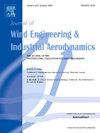基于气流振荡模型的平行巷道上部通风瓦斯聚集的理论研究与控制措施
IF 4.9
2区 工程技术
Q1 ENGINEERING, CIVIL
Journal of Wind Engineering and Industrial Aerodynamics
Pub Date : 2025-06-02
DOI:10.1016/j.jweia.2025.106132
引用次数: 0
摘要
在煤矿开采领域,安全稳定的通风系统是煤矿的生命线,煤、瓦斯突出灾害发生后产生的瓦斯流严重影响竖井内风流的稳定性。因此,研究煤突出后的灾害控制与损失减少具有重要意义。以往对煤矿开环系统气流振荡的研究较少。综合运用理论分析、实验分析、数值模拟等方法研究煤矿开环系统中气流的振荡特性。定义了理想开环分支系统的控制方程,建立了一种考虑空气-甲烷界面分散和混合的数值分析方法,并根据物理模型进行了验证。本文研究了平行倾斜巷道上向通风中气体风压引起的气流振荡特性。通过建模参数化含平行分支巷道的向上通风巷道中停滞甲烷初始气流速度的影响,模拟了控制该向上通风巷道中气流振荡现象的条件,得出了当平行向上通风系统中出现气流振荡现象时,增大初始气流速度可显著减少气流振荡次数的结论。每次振荡的振幅都减小了。当初始风速为0.2 m/s时,出现了多次风向逆转和气流振荡。当初始风速增加到0.35 m/s时,发生了两次气流逆转,逆转后的最大风速差为0.2 m/s。在初始风速为0.5 m/s时,观察到气流的单次反转,但没有振荡行为。倒转后最大风速差为0.16 m/s,在0.5 m/s ~ 0.65 m/s范围内最大风速差为0.16 m/s。反转的差异为0.12 m/s。研究结果对防治井下气流振荡现象,保障煤矿安全生产具有重要意义。本文章由计算机程序翻译,如有差异,请以英文原文为准。
Theoretical research and control measures of gas accumulation based on airflow oscillation model in the upper ventilation of parallel roadway
In the field of coal mining, a safe and stable ventilation system is the lifeline of coal mines, and the gas flow generated after the occurrence of coal and gas protrusion disasters seriously affects the stability of the wind flow in the shafts. Therefore, it is of great significance to study disaster control and loss reduction after coal-gas outburst. Previously, there were fewer studies on airflow oscillations in open-loop systems in coal mines. Comprehensive use of theoretical analysis, experimental analysis, and numerical simulation to study the oscillatory behavior of airflow in coal mine open-loop systems. Control equations for an idealized open-loop branching system are defined, and a numerical analysis method that considers dispersion and mixing at the air-methane interface is developed and validated against a physical model. This study derives the oscillatory behavior of airflow caused by gas wind pressure in upward ventilation of parallel inclined roadways. Using modeling to parameterize the effect of initial airflow velocity of stagnant methane in upward ventilated roadways containing parallel branching roadways, the conditions for controlling the phenomenon of oscillating airflow in such upward roadways were simulated, and it was concluded that when the phenomenon of airflow oscillation occurs in parallel upward ventilated systems, the number of airflow oscillations is significantly reduced by increasing the initial airflow velocity. The amplitude of each oscillation is reduced. When the initial wind speed was 0.2 m/s, several wind flow reversals and airflow oscillations occurred. When the initial wind speed increased to 0.35 m/s, two wind flow reversals occurred, and the maximum wind speed difference after the reversal was 0.2 m/s. At an initial wind speed of 0.5 m/s, a single reversal of airflow was observed, but no oscillatory behavior was noted. After the reversal, the maximum wind speed difference was 0.16 m/s, and the maximum wind speed difference was 0.16 m/s in the range of 0.5 m/s-0.65 m/s. The difference in the reversal was 0.12 m/s. The study results are of great significance for preventing and controlling the phenomenon of underground airflow oscillation and ensuring the safe production of coal mines.
求助全文
通过发布文献求助,成功后即可免费获取论文全文。
去求助
来源期刊
CiteScore
8.90
自引率
22.90%
发文量
306
审稿时长
4.4 months
期刊介绍:
The objective of the journal is to provide a means for the publication and interchange of information, on an international basis, on all those aspects of wind engineering that are included in the activities of the International Association for Wind Engineering http://www.iawe.org/. These are: social and economic impact of wind effects; wind characteristics and structure, local wind environments, wind loads and structural response, diffusion, pollutant dispersion and matter transport, wind effects on building heat loss and ventilation, wind effects on transport systems, aerodynamic aspects of wind energy generation, and codification of wind effects.
Papers on these subjects describing full-scale measurements, wind-tunnel simulation studies, computational or theoretical methods are published, as well as papers dealing with the development of techniques and apparatus for wind engineering experiments.

 求助内容:
求助内容: 应助结果提醒方式:
应助结果提醒方式:


